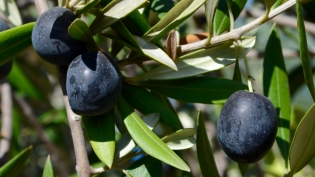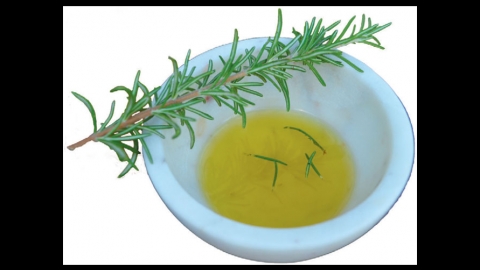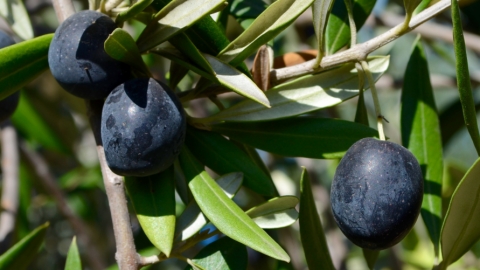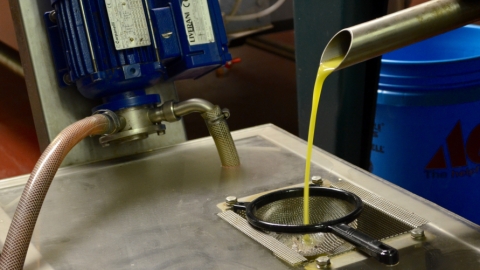Olive Oil Branches Out into Desserts
California's rolling hills and semi-arid landscape often remind me of my train travels through the southern Spanish countryside. The similarities are striking and for good reason: The Spanish missionaries who settled in California along the Camino Real route brought with them new seeds, plants and tree species that left an indelible mark on the native California landscape. Among them was the olive tree.
Today our state boasts 30,000–40,000 acres of groves that annually produce about 160,000 tons of olives, according to 2012 figures from the UC Davis Olive Center and the Agricultural Marketing Resource Center.
Not only is an increasing share of that yield being pressed into lovely olive oils, the quality is giving European varieties a run for their money. Given the health benefits of a diet rich in healthy fats like those found in extra-virgin olive oil, it seems fitting that we take a cue from the Spanish, who are known for using olive oil liberally in savory foods and in cakes, cookies, and even ice cream.
I'd heard that Knead Baking Company in Ojai makes a wonderful citrus-infused olive oil cake with whole orange and lemon peel. In fact, it was served at a luncheon for Alice Waters last summer and is sold from time to time in the bakery. "Olive oil gives a certain lightness and definitive flavor," says Bobbi Corbin, a pastry chef and joint owner of Knead Baking with her daughters Leah and Rachel.
For recipes that ask for vegetable oil, even desserts, she recommends using olive oil. "We use extra-virgin olive oil in our English muffins – it's purer, so you have a better sense of what you're getting."
Of the dessert recipes that I thought could benefit from an olive oil makeover, the one that came to mind was my grandmother's apple pie. Made with a vegetable oil crust, it's filled with Gala apples, a touch of sugar and cinnamon.
Among the things that were passed down to me when we lost my grandmother to Alzheimer's disease, none are more precious to me than her recipes. Written on lined paper in her flowing cursive, she attempted to translate a pinch of this and a scoop of that into a roadmap that might lead us to replicate her simple but homey apple pie or sopaipillas – puffed little squares of fried dough drizzled with honey or cinnamon sugar.
Aside from the small tinge of guilt at tinkering with my inheritance, the only other concern was whether the olive oil would make my crust too savory. The olive oil flavor mellowed during baking and gave the crust an almost nutty quality that really enhanced the flavor and paired well with the sweet apple and cinnamon filling.
With spring's arrival, what I really wanted to make was a shortcake – a sweet little cake that could be a good receptacle for all the fresh fruit that is just too good and too pretty to bake when they're peak of season.
But shortcakes are usually made with cold butter. Given that butter is a solid and olive oil is a liquid, recipes that require creaming butter and sugar or cutting the butter to create air pockets will not achieve the same result when using olive oil, says Corbin. "I would look for recipes that use melted butter instead," she advises.
I decided to give my idea a shot anyway, by taking a basic shortcake recipe and using olive oil in place of the butter.
After a few tries, the result was a tender cake reminiscent of a scone with a lemon-infused interior and a nice, crusty exterior that goes perfectly with macerated fresh berries and sweetened whipped cream.
My shortcakes may not rise quite like a traditional shortcake, but that's OK – the flavor and texture more than make up for its stature. Unlike traditional shortcakes, the olive oil ones stayed moist for several days when stored in an airtight container.
Fran Gage, a certified taster for the California Olive Oil Council, baker and writer, says she's intrigued by using olive oil in desserts and has spent time testing it in classic French recipes.
"I have a recipe for an almost-flourless chocolate cake and I actually like it better with olive oil," says Gage.
While it's generally recommended that bakers choose a mild- to medium-flavored olive oil, like arbequina, those with a more pronounced flavor also can be used. "If you have a good-quality chocolate you can use a strong olive oil and the two will go together very nicely," Gage says.
When replacing butter with olive oil in baking, she recommends using good-quality extra-virgin olive oil and substituting the oil for the butter at three-quarters of the amount.
She advises buyers to look for olive oil sold in a dark bottle, which helps prevent oxidation, and to check the label for a harvest date or "best by" date.
So if the olive oil in your pantry has only graced the salad greens on your plate lately, maybe it's time to branch out and explore what olive oil can do for your sweet tooth.














